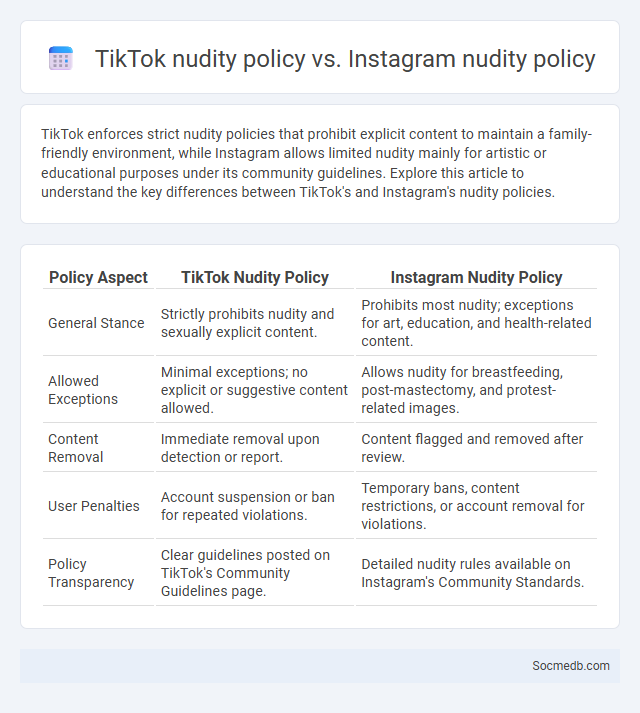
Photo illustration: TikTok nudity policy vs Instagram nudity policy
TikTok enforces strict nudity policies that prohibit explicit content to maintain a family-friendly environment, while Instagram allows limited nudity mainly for artistic or educational purposes under its community guidelines. Explore this article to understand the key differences between TikTok's and Instagram's nudity policies.
Table of Comparison
| Policy Aspect | TikTok Nudity Policy | Instagram Nudity Policy |
|---|---|---|
| General Stance | Strictly prohibits nudity and sexually explicit content. | Prohibits most nudity; exceptions for art, education, and health-related content. |
| Allowed Exceptions | Minimal exceptions; no explicit or suggestive content allowed. | Allows nudity for breastfeeding, post-mastectomy, and protest-related images. |
| Content Removal | Immediate removal upon detection or report. | Content flagged and removed after review. |
| User Penalties | Account suspension or ban for repeated violations. | Temporary bans, content restrictions, or account removal for violations. |
| Policy Transparency | Clear guidelines posted on TikTok's Community Guidelines page. | Detailed nudity rules available on Instagram's Community Standards. |
Overview of TikTok and Instagram Nudity Policies
TikTok and Instagram enforce strict nudity policies to maintain community standards and user safety, prohibiting explicit content while allowing artistic or educational nudity under specific guidelines. TikTok's policy emphasizes removal of sexually explicit material but permits limited exceptions in contexts like breastfeeding or medical content. Instagram restricts full nudity, including genitalia and certain female nipple displays, balancing content moderation with freedom of expression to protect its diverse user base; understanding these rules helps you navigate and create compliant content effectively.
Definitions of Nudity: TikTok vs Instagram
TikTok and Instagram define nudity differently based on their community guidelines, impacting content moderation and user interactions. TikTok restricts explicit nudity more strictly to maintain a family-friendly environment, whereas Instagram allows some artistic or educational nudity under specific conditions. Choosing which platform suits Your content depends on understanding these distinct policies to avoid violations and ensure compliance.
Community Guidelines: Content Restrictions
Social media platforms enforce Community Guidelines to restrict content that includes hate speech, harassment, graphic violence, and misinformation to maintain a safe environment for users. Algorithms and human moderators collaborate to identify and remove posts violating these restrictions swiftly. Users are encouraged to report inappropriate content, helping platforms uphold integrity and protect vulnerable communities.
Age Restrictions and Sensitive Content
Social media platforms enforce strict age restrictions to protect minors from inappropriate content, requiring users to be at least 13 years old in compliance with COPPA regulations. Sensitive content filters can automatically detect and limit exposure to graphic, violent, or adult material, ensuring safer browsing experiences. To maintain your privacy and well-being, you should customize these settings based on your preferences and verify age restrictions when creating accounts.
Artistic Nudity: Policy Differences
Social media platforms exhibit significant policy variations regarding artistic nudity, with Instagram enforcing strict content guidelines that often blur the line between art and explicit material, while platforms like Tumblr have adopted more permissive stances allowing a broader range of artistic expression. These differences impact content creators and artists who use social media to share works featuring nudity, influencing visibility, community engagement, and censorship risks. Understanding each platform's terms of service and content moderation practices is crucial for maintaining compliance and maximizing artistic reach.
Enforcement and Moderation Methods
Effective social media platforms implement rigorous enforcement and moderation methods, combining AI algorithms with human review to detect and remove harmful content swiftly. Your online safety is ensured through real-time monitoring systems that flag hate speech, misinformation, and spam, reinforcing community guidelines. Transparent appeal processes and adaptive moderation strategies maintain platform integrity while respecting user rights.
Appeals and Content Removal Process
Social media platforms use appeals processes to ensure fair review of content removal decisions, allowing users to challenge the moderation actions taken against their posts. Your appeal generally involves submitting a request explaining why the content complies with community standards, after which moderators reassess the content's eligibility. Understanding the specific guidelines and timelines for appeals can improve your chances of successful content restoration on major platforms like Facebook, Instagram, and Twitter.
Banned Content Comparison
Social media platforms have distinct policies on banned content to ensure community safety and compliance with legal standards. Content involving hate speech, graphic violence, and misinformation is commonly prohibited, but variations exist--for example, Facebook bans coordinated hate groups, while Twitter enforces strict rules against misleading political information. Understanding these differences helps you navigate each platform effectively and avoid content violations.
User Experiences and Public Reactions
Social media platforms continually evolve to enhance user experiences through personalized content algorithms and interactive features like live streaming and augmented reality filters. Public reactions to trending topics often manifest rapidly, creating viral movements and shaping online discourse within hours. User-generated reviews and real-time feedback significantly influence platform improvements and community guidelines enforcement.
Future Trends in Social Media Content Policies
Future trends in social media content policies are increasingly defined by AI-driven moderation and enhanced transparency requirements to combat misinformation and harmful content. Platforms will prioritize real-time content analysis using advanced algorithms that adapt to evolving language nuances and cultural contexts. You can expect stricter regulations enforcing accountability from both users and providers, ensuring safer and more responsible digital environments.
 socmedb.com
socmedb.com